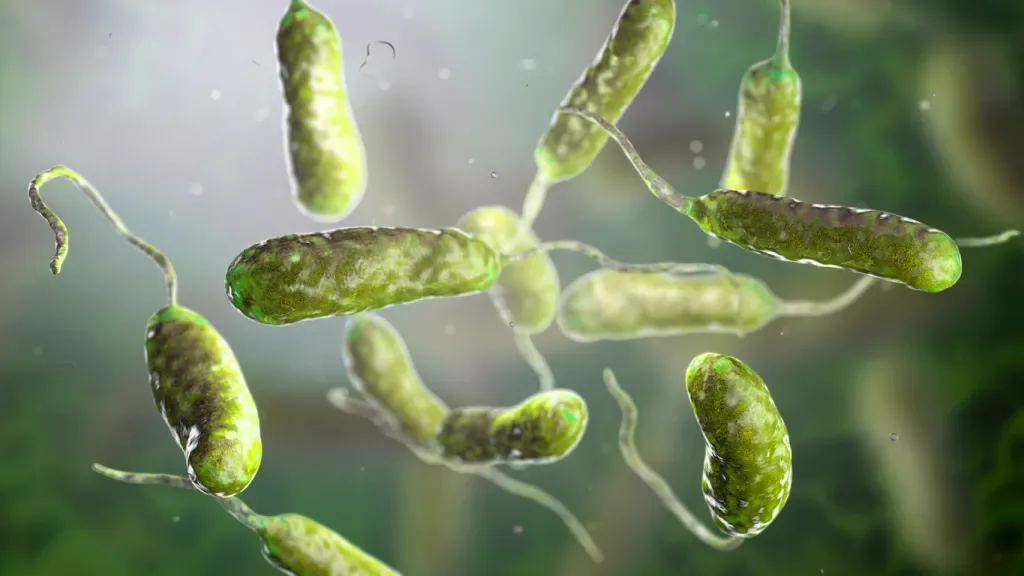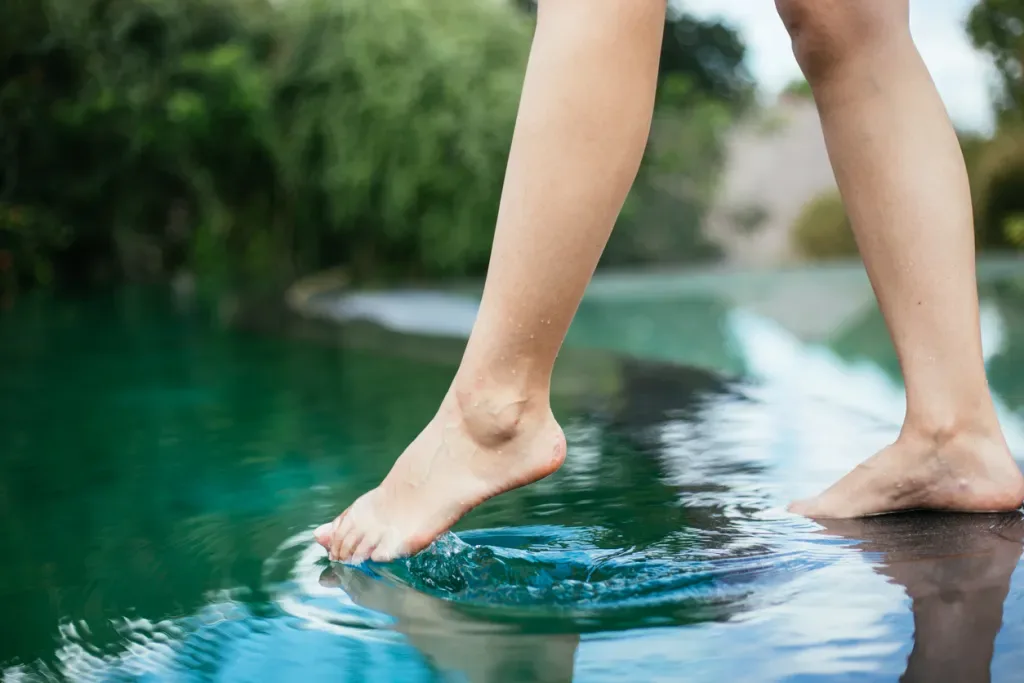Recent news stories suggest that a certain bacteria previously unseen in the Atlantic is rearing its head.
Chilly waters once created an environment that the microscopic critters couldn’t tolerate. But with sea temperatures rising, is the Atlantic no longer safe?
We’re looking into the stories and sussing out the truth. Don’t put away your bathing suits just yet.
Let’s dive in!

Flesh-Eating Bacteria Are Moving Into the North Atlantic Region
One of the most terrifying stories from the 1990s was about the flesh-eating Vibrio vulnificus. This unseen monster infected swimmers along the Gulf Coast, resulting in horrifying injuries.
At the time, amputation or death was the only way to stop it entirely.
According to WIRED magazine, the bacteria is making a comeback. Far from its traditional stomping grounds, researchers are now finding them as far north as New York and Connecticut.
ABC News reported that over the summer of 2023, officials attributed at least six deaths to the bacteria along the Atlantic. With around 80,000 infections caused by them each year in the US alone, it’s likely an underreported number.
And the damage isn’t just felt in the tourism industry. It also affects seafood. Remember the old adage about not eating oysters in months with an “r” in their name? That’s because they’re brimming with these nasty little buggers.
Sadly, scientists don’t think they’re going away. In fact, we’ll probably see an increase over the coming years. But don’t give up on your seaside vacation. There’s more to the story.
About the Bacteria Wreaking Havoc in the Atlantic Ocean
Vibrio vulnificus is part of a family of bacteria that cause illness when ingested or contacted by humans. They’re most at home in specific water temperatures and can’t survive if it’s too cold or hot. Until recently, they only lived in warm waters around the Gulf of Mexico and Florida. But as times have changed and populations shifted, they’ve expanded their reach.
Several factors contribute to their sudden mobility. Ocean temperatures in the Northeast are rising, providing the perfect habitat. Add to that increased runoff from growing cities on the coast, and you’ve got ideal conditions for an explosion.
Not all species cause necrotizing fasciitis in humans. Only V. vulnificus can inflict the sort of damage you’ve probably seen on the news. For folks in the North Atlantic, the bacteria isn’t well known, which is problematic. Doctors can’t always identify the infections right away, and delayed treatment means a higher chance for sepsis to set in.
Thankfully, the Food and Drug Administration has a rigorous protocol for testing seafood to keep them off our dinner plates. But there’s nothing of the sort to protect swimmers.
While not everyone who enters the water is necessarily at risk, those with open wounds, even tiny ones, are susceptible. Something as innocuous as a fresh tattoo can be an entry point.
It’s not just bacteria that are invading the northern Atlantic: Are Great White Sharks as Far North as Massachusetts?
What Are the Symptoms of a Vibrio Infection?
According to the Centers for Disease Control (CDC), Vibrio infections in the Atlantic and Gulf regions are common. Usually, people contract it by consuming raw seafood contaminated with the bacteria.
Ingesting them can result in watery diarrhea, abdominal cramping, and vomiting. Within 24 hours of eating them, you may also experience fever and chills. Lasting around three days on average, it’s not typically fatal. However, those with compromised immune systems can have complications.
As we mentioned, the only flesh-eating Vibrio species is V. vulnificus. If you have even a tiny break in the skin, beware. Coming in contact can result in a nasty infection.
Living in coastal areas with seawater or brackish water puts you at risk. Necrotic fasciitis is when the tissue around a wound begins to die. Skin becomes red, warm, and swollen and is severely painful. Later stages include blisters and ulcers coupled with changes in skin color and oozing sores.
Seek medical attention immediately if you’ve potentially been exposed and are experiencing these symptoms.
CDC guidelines have changed recently as well. Doctors in regions with the microbe generally give patients antibiotics right away. Severe impact is possible within two days, so time is of utmost importance.
What Are the Odds of Getting Infected With Vibrio Bacteria in the Atlantic Ocean?
So, we should all just avoid the Atlantic as long as the bacteria is around, right? Not so fast.
We’ve already noted that over 80,000 people contract vibriosis each year and survive. It’s much more common to ingest through undercooked seafood than you think.
Some folks are more likely to have a severe reaction as well. Those with liver disease or who are immunocompromised often get the raw end of the deal. Cancer, diabetes, and HIV all also increase the likelihood of infection.
A cut, however, could make your prognosis much worse. Unless treated immediately, the odds of survival change significantly. One in five of these cases results in death. It’s doubtful that you’ll have a fatal encounter with these microbes. But if you swim in the ocean and have a cut that looks infected after, get help now.
The land can have dangers too: Deadly Mice in Our National Parks.
Can You Survive a Vibrio vulnificus Bacteria Infection From the Atlantic?
With the odds of surviving this skin infection at only 80 percent, it’s not something you should ignore. The impact could be greater because folks along the Atlantic coast aren’t as familiar with the bacteria. Although Gulf states are used to dealing with the issue, it’s been unusual farther north.
The best way to protect yourself is to assume that all seawater is contaminated. That way, if you notice symptoms after swimming, you’ll know what to do. Seek medical attention right away. If you start antibiotics immediately, you’ll likely be okay.
Treatment for necrotic tissue is almost as bad as the wound itself. Doctors may debride the area if necessary. This process removes dead flesh through surgical or chemical means. If this approach doesn’t work and the microbe keeps spreading, the only option is amputation.

How to Protect Yourself From Dangerous Bacteria in the Atlantic
While vibriosis is certainly scary, you may not need to avoid the Atlantic entirely when the bacteria is present. There are several ways to protect yourself that don’t involve moving inland.
If you have an open wound, fresh piercing or tattoo, or had surgery, stay away from brackish or seawater. Simply wading at the beach is a no-go. When that’s not possible, such as during natural disasters, cover it with a waterproof dressing.
Contact is sometimes inevitable, so wash skin breaks with soap and water following exposure. At the first sign of symptoms, seek care without delay.
Fever, redness, pain, and swelling are all signs of a festering cut. Add to that heat, discoloration, and seepage, and you’re in trouble. Get to an ER and tell the medical team what you think is happening. If you try to tough it out, it might be the last thing you do.
Does even a small risk make you nervous? Cool off with an Inflatable Pool instead.
Be Cautious, But Not Afraid
Recent news that flesh-eating bacteria are invading the North Atlantic caught the attention of many. But just because there’s a chance you’ll come in contact with the microbes doesn’t mean beach days are gone.
Common sense and good judgment go a long way toward keeping you safe. And if you have fresh ink or even a paper cut, stay out of the water!
Discover the Best Free Camping Across the USA
To be honest with you, we hate paying for camping. There are so many free campsites in America (with complete privacy).
You should give it a try!
As a matter of fact, these free campsites are yours. Every time you pay federal taxes, you’re contributing to these lands.
Become a FREE CAMPING INSIDER and join the 100,000 campers who love to score the best site!
We’ll send you the 50 Best Free Campsites in the USA (one per state). Access the list by submitting your email below: